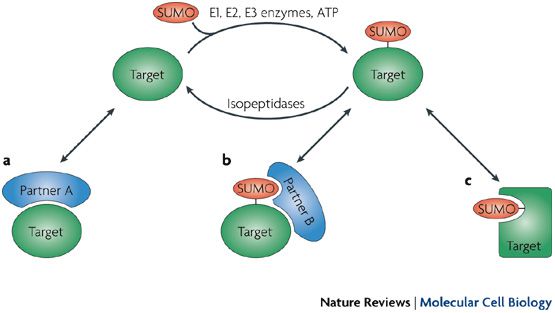-
 Electromagnetic field
Electromagnetic field
-
 Beak
Beak
-
 Decussation
Decussation
-
 Dextrocardia
Dextrocardia
-
 Blende
Blende
-
 Replication
Replication
-
 Catarrh
Catarrh
-
 Nintendo DS
Nintendo DS
-
 Excited state
Excited state
-
 Incense cedar
Incense cedar
-
 ArXiv
ArXiv
-
 Combined pill
Combined pill
-
 Micral
Micral
-
 Polling
Polling
-
 Quantum electrodynamics
Quantum electrodynamics
-
 Pomegranate
Pomegranate
-
 Naevus
Naevus
-
 Mid-oceanic ridge
Mid-oceanic ridge
-
 EDI
EDI
-
 Mucitis
Mucitis
-
 Scanning electron microscope
Scanning electron microscope
-
 iPod Nano
iPod Nano
-
 Hypothalamic paraventricular nucleus
Hypothalamic paraventricular nucleus
-
 CDC
CDC
-
 Dementia
Dementia
-
 Hepatitis E
Hepatitis E
-
 Threshold dose
Threshold dose
-
 Ampere
Ampere
-
 Sodium valproate
Sodium valproate
-
 Silver birch
Silver birch
Sumoylation (SUMOylation)
Sumoylation is one of the post-translational modifications commonly seen in proteins.
This involves the covalent binding of a peptide called SUMO to specific sites on the proteins made up of lysine amino acids.
Sumoylation occurs in three stages and involves 2 to 3 catalytic enzymes:
- maturation: cleavage of the C-terminal end of the peptide SUMO;
- activation: creation of a thioester link between SUMO and the binding enzyme;
- conjugation: the activated SUMO is bound to the proteins.
Four types of SUMO proteins have been described until now.
Sumoylation leads to a change in the sumoylated protein: it may enable it to recruit a new partner or change its conformation.
Although related to ubiquitination (which leads to degradation of the target protein) in its biochemical process, sumoylation enables very different functions. These include regulation of the cell cycle, stabilisation of the protein, nuclear-cytoplasmic transport, regulation of transcription, etc.
 Sumoylation causes a change in the target protein. a) the non-sumoylated protein can bind to the partner A, b) the sumoylated protein combines to a new protein B, but no longer with A, c) the protein changes conformation and no longer binds. © Nature reviews / Molecular Cell Biology
Sumoylation causes a change in the target protein. a) the non-sumoylated protein can bind to the partner A, b) the sumoylated protein combines to a new protein B, but no longer with A, c) the protein changes conformation and no longer binds. © Nature reviews / Molecular Cell Biology
Latest
Fill out my online form.



